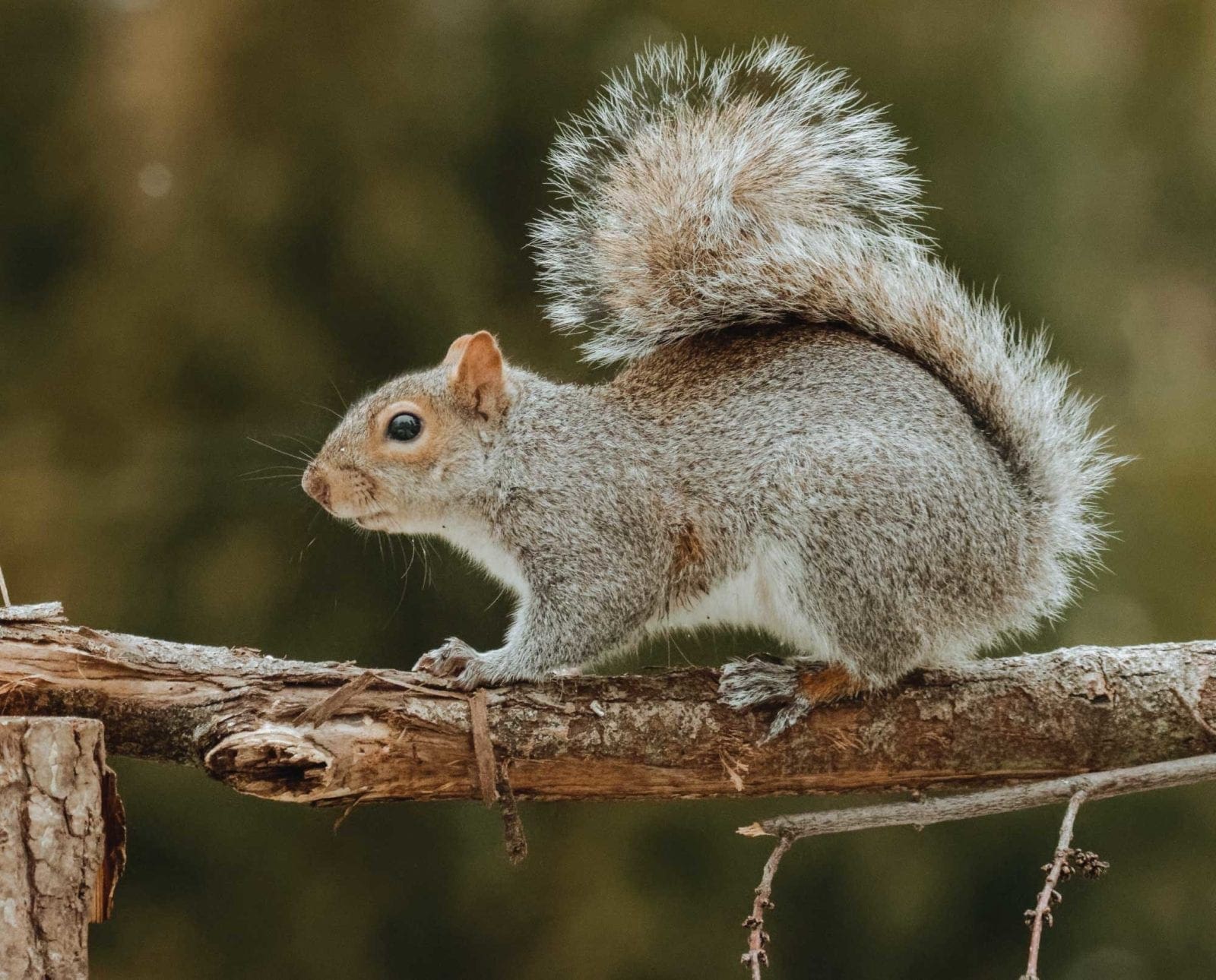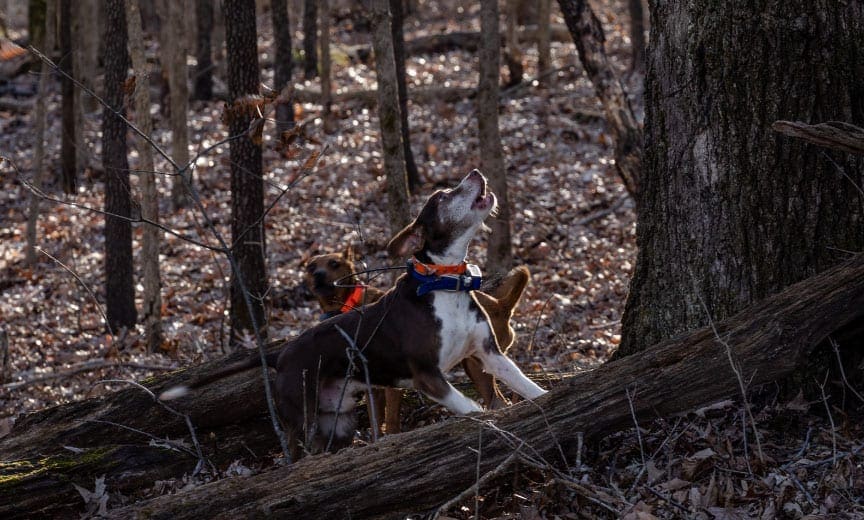Home » Small Game Hunting » Squirrel Hunting » Eastern Gray Squirrel (Sciurus carolinensis) – A Small Game Species Profile
Eastern Gray Squirrel (Sciurus carolinensis) – A Small Game Species Profile

Ryan Lisson is a biologist and regular content contributor to…
Tree rats, bushy tails, and squirrels – great no matter what you call them
We know what you’re thinking, and you’re right. A squirrel is most definitely not an upland bird. But it is one of America’s most common small game/upland mammal species. And only a couple decades ago, virtually every hunter was also a squirrel hunter. While the squirrels are still common, the squirrel hunter has declined substantially since then. That’s a real shame because the Eastern gray squirrel (Sciurus carolinensis) – or grey squirrel, tree rat, or bushy tail, depending on where you’re from – is a wonderful animal to hunt and makes excellent table fare. Here’s some background on this common little tree dweller, and how you can start hunting them if you haven’t before.
Description and life history of the gray squirrel
Although there are a few subspecies of gray squirrels in North America, the Eastern gray squirrel is by far the most commonly hunted and familiar to most people. It weighs about one to two pounds on average and can measure about 20 inches in length due to its long tail (NatureServe 2019). The fur on their head, back, side, and tail is generally grayish-brown, while their underside is usually whiter in color. However, melanistic squirrels (all black in color) are also somewhat common in certain populations. They generally have large, fluffy tails (earning them the nickname “bushy tails”) which they can use to keep warm during the winter. Males and females look basically the same from a size and color perspective.
Gray squirrels may produce up to two litters in a given year. As fall approaches, individuals will find a potential nest site, which is often in a tree cavity or standing snag (dead tree). In the absence of a tree hollow, they may also fashion a ball-like nest in the tree canopy out of leaves and sticks. Starting in December to February (and potentially again in May through August), gray squirrels will mate with one another and part ways (Minnesota DNR 2019; NatureServe 2019). Females often raise litters of 2 to 3 kits (babies), which are born blind, hairless, and fairly helpless compared to most precocial birds (e.g., ruffed grouse). The female will tend them for 10 to 12 weeks until they are fully weaned.
Gray squirrels survive on a diverse diet, which varies significantly depending on where they live. Generally, however, the following food items are important for them: seeds (including agricultural grains), nuts (e.g., acorns, hazelnuts, hickory nuts, walnuts, etc.), fruits, fungi/mushrooms, tree/shrub buds, insects, and even small vertebrates (Minnesota DNR 2019; NatureServe 2019). In urban areas and parks, they may also consume a great deal of scavenged waste. Squirrels are known to hoard food in the fall by burying it somewhere with the intention of returning later in winter to consume it. It is believed that squirrels play an important ecological role and are efficient little foresters; many an acorn has sprouted into an oak tree as a result of a forgetful squirrel.
Unfortunately for gray squirrels, which are at the bottom of the food chain, predators abound. Domestic cats, raptors (e.g., hawks, owls, etc.), coyotes, foxes, weasels, and bobcats are all efficient squirrel hunters (Minnesota DNR 2019; NatureServe 2019). Humans used to take a higher percentage of them, but as mentioned above, squirrel hunting sort of fell out of practice years ago and is just now making a bit of a resurgence.
Range and habitat of the gray squirrel
Given its name, the Eastern subspecies of gray squirrel occurs (not surprisingly) in the eastern half of the country. They live in habitats throughout the central and eastern part of North America, from southern Quebec in Canada down to Texas and the Gulf Coast of the United States. Along the Pacific Coast and Northwest, the western gray squirrel is more common, while the Arizona gray squirrel lives in the Desert Southwest.
Gray squirrels are primarily associated with mature deciduous/hardwood forests, especially those with a lot of hard mast trees (e.g., oak, hickory, etc.) (NatureServe 2019). The tall, park-like trees offer lots of nesting opportunities, including in the canopy itself or within the many cavities and hollows that develop in older tree trunks. Additionally, these forests generally provide multiple food sources, including nuts (e.g., acorns, walnuts, hickory nuts, etc.), seeds, fruits, and fungi. However, gray squirrels can also live quite well in urban parks and suburban backyards, where bird feeders, gardens and human food waste supply much of their diet.
Conservation issues for the gray squirrel
The Eastern gray squirrel is extremely common throughout North America and in no danger of disappearing from it anytime soon. Americans really like their mature, park-like forests, which can be a bummer for young forest species but good news for squirrels. They are listed as globally secure and of Least Concern by the IUCN Red List (NatureServe 2019). As mentioned above, gray squirrels are very adaptable animals that can thrive in urban areas or remote wilderness locations alike.

Hunting opportunities for the gray squirrel
This is the interesting part of the gray squirrel’s history in America. In decades past, it was very common for people to walk out behind their house in rural America and go shoot some squirrels for dinner. In the last couple decades though, that trend seems to have taken a major nose-dive. Perhaps it’s because more people live in urban or suburban areas, or the pay-off (in meat) doesn’t seem worth the effort (which isn’t really true). Thankfully, squirrel hunting is starting to take off again. It’s a perfect species for someone’s first time hunting — the gear is so minimal, it involves smaller rifles or shotguns, and it can be done for an extended season. So if you’re interested in trying it, how exactly do you start?
You should start by figuring out how you want to hunt. There are two primary ways of hunting squirrels. The first is via ambush, where you go out early in the morning and get comfortable against the base of a tree. As the squirrels come out to feed in the morning light, you stealthily make the shot without them knowing you’re there (hopefully). Alternatively, you can simply walk through the woods and wait to jump a squirrel. They will generally be running or scampering up a tree into a cavity with this method, but you also get to stay active and see a lot of ground that way.
As far as gear goes, you don’t need much – good hunting boots, blaze orange clothing (regulations vary by state), and a firearm. A .22 caliber rimfire rifle or a .28 gauge shotgun will be plenty powerful enough to kill a squirrel. If you use much more than that, it will still be effective but you risk destroying too much meat. A rimfire rifle (.22 LR) is nice for ambush hunts since the squirrel shouldn’t know you are there and you should be able to get a head shot at a relatively motionless animal (squirrels never really stop moving for long). But a shotgun is nice if you will be actively hunting and likely shooting at a moving squirrel – it just provides a better margin for success.
If squirrel hunting is brand new to you or you just haven’t done it for a few decades, maybe now is the time to pick it up. You can learn a lot of the basic hunting skills by doing so, and squirrel is actually very tasty when braised or fried.
Sources:
Minnesota DNR. 2019. Gray Squirrel. Accessed at: https://www.dnr.state.mn.us/mammals/graysquirrel.html
NatureServe. 2019. NatureServe Explorer: An online encyclopedia of life. Accessed at http://explorer.natureserve.org
Ryan Lisson is a biologist and regular content contributor to several outdoor manufacturers, hunting shows, publications, and blogs. He is an avid small game, turkey, and whitetail hunter from northern Minnesota and loves managing habitat almost as much as hunting. Ryan is also passionate about helping other adults experience the outdoors for their first time, which spurred him to launch Zero to Hunt, a website devoted to mentoring new hunters.




As a lifelong squirrel hunter I would like to say that pretty much any shotgun gauge can take squirrels without damaging meat. I have taken hundreds of squirrels with 12 gauges and size 6 or 5 shot works great. If you know the pattern of your gun, you can “edge” the squirrel and concentrate the pellets in the head, neck, and shoulder area. The 28 gauge can be a fine squirrel gun, but novice squirrel hunters shouldn’t feel like they have the wrong gun if they do not have a 28.
I have just recently acquired a new Henry Repeating Arms lever action .410. It is chambered for 2.5 inch and while I would love to see it in 3 inch I was pleasantly surprised at the range I was able to get from this great little gun. You definitely have to get a bit closer, but coupled with a Briley ported XFULL choke this lever action .410 is a fun gun to shoot and to hunt bushy tails, especially during our spring season here in Kentucky.
Squirrel hunting is a lot of fun. Early season, I go out with my 16 ga SxS since they are running around in the trees. Late season means getting the .22LR and ambushing them as they come out in the forest. Making squirrel tacos or squirrel noodle soup is my favorite. Even my wife and 6 year old daughter like to eat them.
Oh my god we must act! The very existence of squirrel hunters is in peril! Personslly i would get a couple beforei caught the school bus in 6 th grade eith my sigle shot 410. It was not from neccessity but for sport and i would clean them and put in the freezer before the bus mybe having time to clean myself or maybe not.